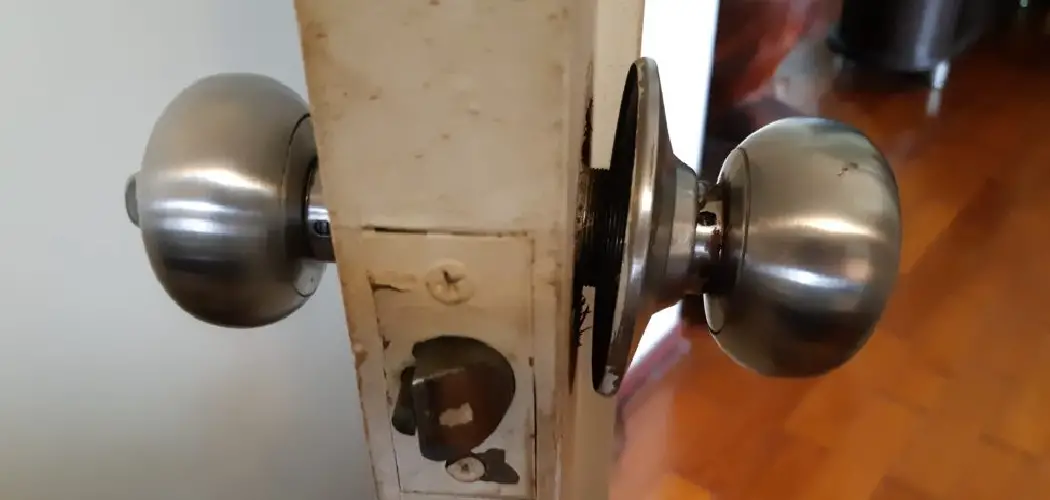A loose doorknob can be both a nuisance and a potential security risk, but tightening it is a straightforward DIY task that can restore functionality and stability to your door. Whether it’s a knob that wiggles or spins freely, addressing the issue promptly can prevent further damage and ensure smooth operation.
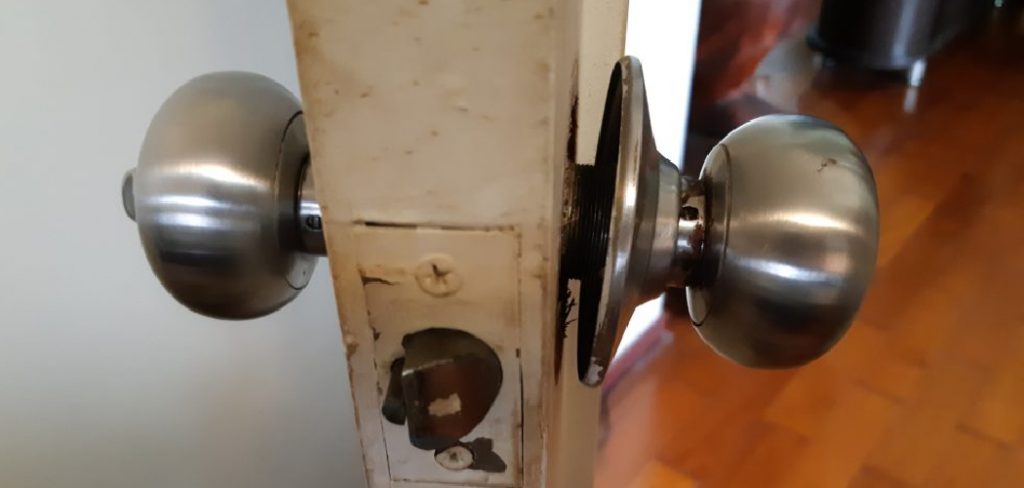
In this article, we’ll explore various methods for how to tighten a loose doorknob, from simple adjustments to more involved repairs. With a few basic tools and some know-how, you can quickly and easily tighten any loose doorknob, restoring security and peace of mind to your home or office.
The Annoyance and Security Risk
A doorknob that doesn’t sit firmly in its place not only undermines the ease of entering and exiting a room but also poses a significant security risk. Imagine finding yourself unable to securely lock a door or, conversely, struggling to open it when you need to exit quickly. Such scenarios highlight the gravity of a seemingly minor issue.
The annoyance of a wobbling doorknob, combined with the stress of potentially compromised security, can disrupt the daily routine and comfort of your living or working environment. Addressing this problem not only alleviates these immediate concerns but also prevents the situation from escalating into a more serious security flaw, where the door cannot be reliably locked or unlocked.
Importance of Addressing a Loose Doorknob
Neglecting a loose doorknob can lead to a cascade of issues beyond the initial inconvenience and security risks. Over time, a doorknob that is not securely attached can cause damage to the door itself, potentially warping the area around the doorknob or damaging the locking mechanism.
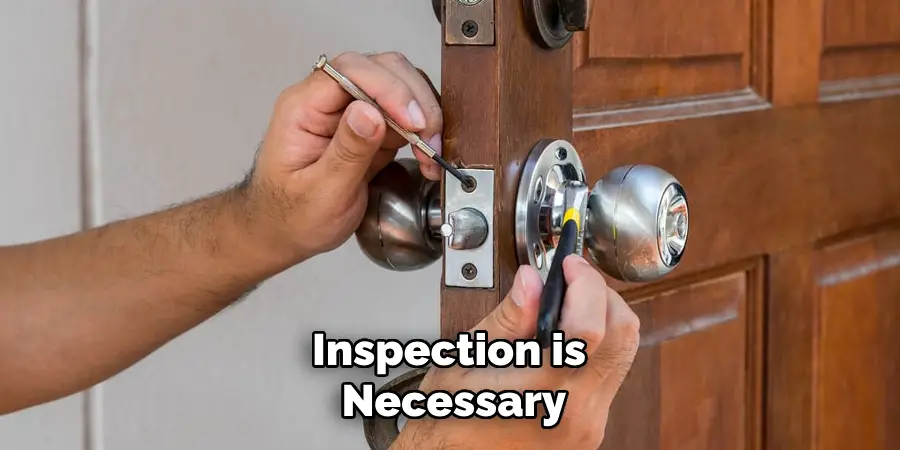
This makes the repair more complex and costly down the line. Furthermore, a loose doorknob can be symptomatic of broader structural issues with the door or its frame, indicating that a thorough inspection may be necessary. Proactively addressing a loose doorknob ensures the longevity and functionality of your door, saving time, money, and enhancing the overall safety of your environment.
Causes of a Loose Doorknob
Several factors can contribute to a doorknob becoming loose over time, impacting its functionality and security. One common cause is regular wear and tear; frequent use can gradually loosen the screws that hold the doorknob assembly together, leading to a lack of stability. Additionally, changes in humidity and temperature can cause the door material—particularly if it’s wood—to expand and contract. This natural movement may result in the loosening of the doorknob’s components.
Improper installation is another factor; if the doorknob was not correctly installed to begin with, it’s more likely to become loose sooner. Lastly, accidental impacts or excessive force used on the doorknob can dislodge its components, necessitating adjustments or repairs to ensure the doorknob is securely fastened once again. Understanding these causes is the first step towards effectively addressing and preventing a loose doorknob.
Common Reasons Why Doorknobs Become Loose Over Time
Doorknobs, as integral components of daily life, are subject to a variety of factors that contribute to their loosening over time. One of the primary reasons is the natural wear and tear from daily use. Each turn and twist applies a small amount of pressure on the screws and mechanism, gradually leading to looseness. Environmental factors also play a significant role; changes in humidity and temperature can cause both wooden doors and metal components to expand and contract, upsetting the snug fit of a doorknob.
Additionally, the quality of installation initially undertaken can significantly affect the longevity of the doorknob’s tightness. Incorrectly installed doorknobs may lack the necessary tightness or alignment, leading to premature loosening. Impact and abuse, such as slamming doors or hanging heavy items on the knob, can also accelerate the loosening process. Understanding these common reasons can aid in both prevention and timely maintenance, ensuring that doorknobs remain functional and secure.
Examining the Doorknob for Visible Signs
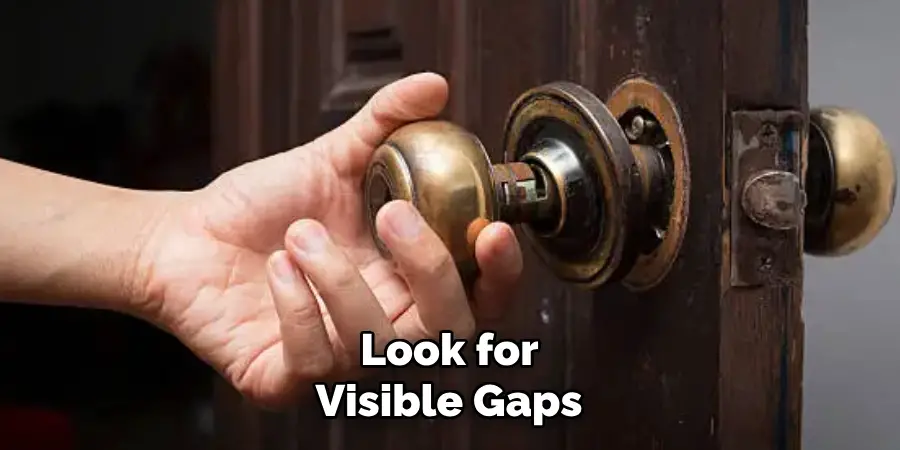
Before proceeding with any repairs, it’s crucial to closely inspect the doorknob for any visible signs of damage or wear. This step will help you understand the extent of the issue and determine the most appropriate course of action. Look for visible gaps between the doorknob and the door surface, as these can indicate screws or components that have become loose over time.
Check for any screws that appear to be missing, since this could explain the doorknob’s lack of stability. Additionally, assess the condition of the doorknob itself—cracks, rust, or other forms of damage on the knob or surrounding hardware can also lead to looseness. This examination should provide a clear understanding of whether the doorknob requires tightening, a few replacement parts, or a complete replacement. Remember, identifying the specific problem is key to a successful fix.
Testing the Handle for Wobbling or Rattling
Once the initial examination is complete, the next crucial step is to test the doorknob for any wobbling or rattling. This involves physically handling the doorknob to feel for any movement that shouldn’t be there. Gently turn the knob in both directions, and also try pulling it towards you and pushing it away. A stable doorknob should feel firm and secure, without any side-to-side movement or play.
If you notice the doorknob moving or hear a rattling noise, it’s a clear indication that parts within the doorknob assembly are loose. This test not only confirms the presence of an issue but also helps in determining the severity of the looseness. Based on the outcome of this testing, you can decide whether a simple tightening procedure is sufficient or if more comprehensive measures are required to secure the doorknob properly.
10 Methods How to Tighten a Loose Doorknob
1. Tighten the Set Screw:
Many doorknobs have a set screw located on the collar or base of the knob that holds it securely to the spindle. If your doorknob is loose, start by locating the set screw using a small hex key or screwdriver. Tighten the set screw clockwise to secure the knob to the spindle. Be careful not to overtighten the screw, as this could strip the threads or damage the knob.
2. Adjust the Spindle Screws:
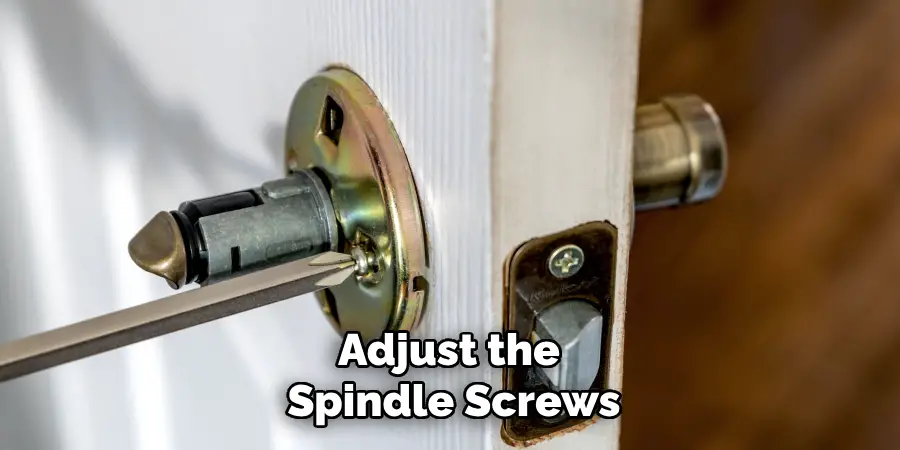
Some doorknobs have screws on the spindle that allow you to adjust the tension and fit of the knob. To tighten a loose doorknob with spindle screws, use a screwdriver to tighten the screws located on the collar or base of the knob. Turn the screws clockwise until the knob feels snug and secure. Test the knob to ensure that it no longer wiggles or spins freely.
3. Replace the Set Screw:
If the set screw on your doorknob is stripped or damaged, it may not effectively hold the knob in place. In this case, you’ll need to replace the set screw with a new one of the same size and thread pitch. Remove the old set screw using a screwdriver or hex key and take it to a hardware store to find a replacement. Install the new set screw in the same location and tighten it securely to fix the loose knob.
4. Add Thread Locking Compound:
To prevent the set screw from loosening over time, you can apply a small amount of thread locking compound to the threads before tightening the screw. Thread locking compound is a type of adhesive that creates a strong bond between threaded components, preventing them from vibrating loose. Apply a drop of thread locking compound to the threads of the set screw and then tighten the screw securely. Allow the compound to cure according to the manufacturer’s instructions before using the doorknob.
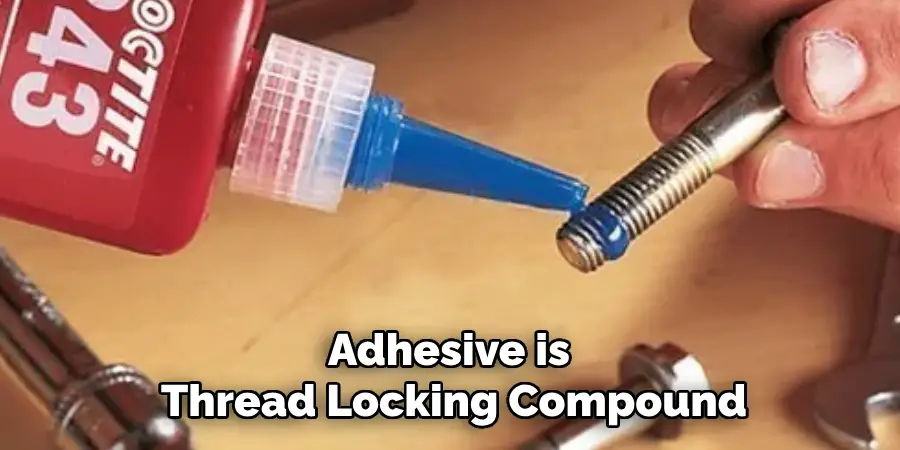
5. Replace the Set Screw with a Longer Screw:
If the set screw on your doorknob does not effectively engage with the spindle, you may be able to replace it with a longer screw to provide better grip and stability. Measure the length and diameter of the existing set screw and purchase a replacement screw that is slightly longer. Install the longer screw in the same location and tighten it securely to secure the knob to the spindle.
6. Tighten the Door Knob Assembly Screws:
In addition to the set screw and spindle screws, many doorknobs have screws that attach the entire knob assembly to the door. If your doorknob is loose, check the screws on both sides of the door to ensure that they are tight. Use a screwdriver to tighten any loose screws until the knob feels secure and stable. Be sure to tighten both the screws on the exterior and interior sides of the door for maximum stability.
7. Replace Worn or Damaged Parts:
If tightening the screws does not resolve the issue, the problem may be due to worn or damaged internal components of the doorknob assembly. Inspect the knob, spindle, and other parts for signs of wear or damage, such as stripped threads or cracked components. If any parts are worn or damaged, replace them with new ones to restore functionality and stability to the doorknob.
8. Use a Backing Plate or Rosette:
In some cases, a loose doorknob may be caused by a worn or damaged backing plate or rosette that attaches the knob assembly to the door. To reinforce the connection between the knob and the door, you can install a backing plate or rosette behind the knob assembly. These metal plates provide additional support and stability, preventing the knob from wobbling or coming loose. Simply remove the existing knob assembly, install the backing plate or rosette behind it, and then reattach the knob assembly to the door.
9. Apply Epoxy Resin:
If the screw holes in the door or knob are stripped or enlarged, making it difficult to tighten the screws securely, you can use epoxy resin to create new threads and provide a stronger grip. Start by cleaning the screw holes thoroughly with a solvent to remove any debris or grease. Mix the epoxy resin according to the manufacturer’s instructions and apply it to the screw holes using a toothpick or small brush. Insert the screws into the holes and tighten them securely. Allow the epoxy resin to cure completely before using the doorknob.
10. Consult a Professional:
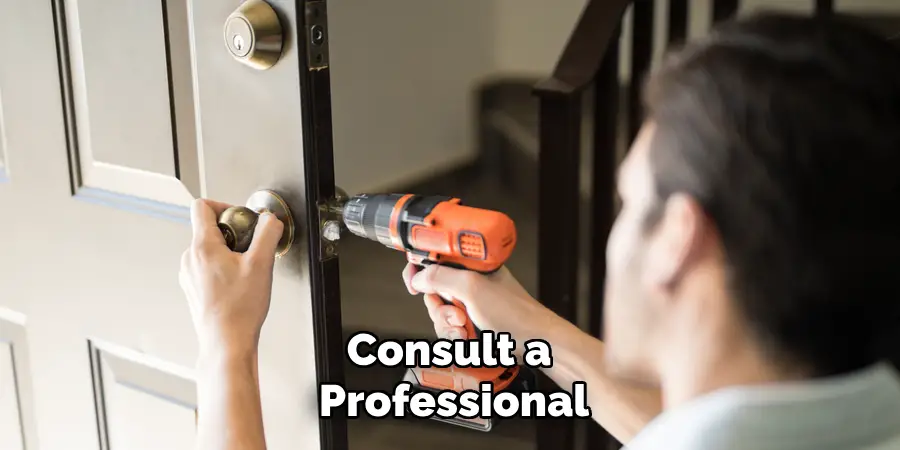
If you’re unable to tighten the loose doorknob yourself or if the problem persists despite your best efforts, it may be time to consult a professional locksmith or door hardware specialist. A professional can assess the issue and recommend the best course of action for repairing or replacing the loose doorknob. They may also have access to specialized tools and replacement parts that are not readily available to the average homeowner.
Tools and Materials Needed
To tighten a loose doorknob and address any issues related to it, having the right tools and materials is essential. Here’s a list to ensure you’re well-prepared:
- Hex Key or Allen Wrench Set: Needed for tightening set screws on the doorknob.
- Flat-head and Phillips Screwdrivers: Useful for adjusting spindle screws and securing assembly screws.
- Thread Locking Compound: This adhesive prevents screws from loosening over time due to vibration.
- New Set Screws or Longer Screws: Depending on the solution required, you might need replacements of the appropriate size and thread pitch.
- Epoxy Resin: To repair stripped or enlarged screw holes, creating a solid base for the screws.
- Toothpicks or Small Brushes: To apply epoxy resin accurately into screw holes.
- Backing Plate or Rosette (If Applicable): Provides additional support if the doorknob or the door is damaged.
- Measuring Tape: To measure the existing set screws and determine the size of any replacements needed.
- Solvent: For cleaning screw holes before applying epoxy resin.
- Rags or Paper Towels: For clean-up and wiping away any excess materials.
Ensure all materials are compatible with your doorknob and door material to avoid any damage or further issues.
Tips and Tricks for Preventing Future Looseness
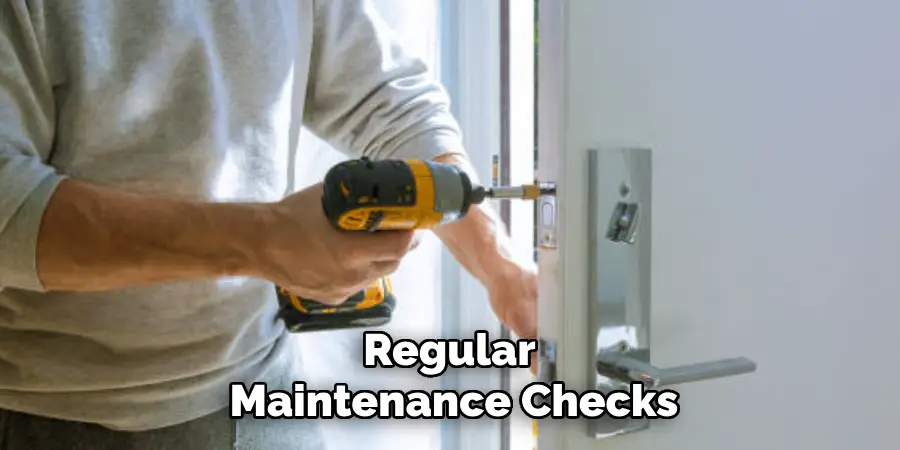
Maintaining a tight and functional doorknob requires more than just occasional repairs; preventive measures play a crucial role. Here are some tips and tricks to ensure your doorknob remains secure and operational:
- Regular Maintenance Checks: Periodically inspect your doorknob and its parts for signs of wear or looseness. Early detection can prevent minor issues from becoming major problems.
- Proper Usage: Encourage gentle use of the doorknob. Avoid excessive force or pulling on the knob, as this can accelerate wear and contribute to loosening.
- Lubricate Moving Parts: Apply a silicone-based lubricant to the doorknob’s moving parts at least once a year. This will keep the mechanism smooth, reducing strain on the components.
- Check for Alignment Issues: Misaligned doors can put additional stress on doorknobs and their hardware. Ensure that your door is properly hung and that the latch and strike plate are aligned.
- Tighten Screws Regularly: Even without signs of looseness, make it a habit to tighten the screws of your doorknob assembly and set screws during your regular maintenance checks.
- Avoid Over-tightening: While it’s important to keep components tight, over-tightening can strip screws and damage the doorknob. Turn screws until they are snug, but do not force them beyond resistance.
By implementing these preventative measures, you can significantly reduce the likelihood of a loose doorknob in the future, keeping your door functional and secure.
Regular Maintenance and Inspection Schedule
Establishing a routine maintenance and inspection schedule is critical for ensuring the longevity and proper functioning of your doorknob and door hardware. By setting a timeline for regular checks, you can identify and address potential issues before they escalate into more significant problems. Here is a suggested maintenance schedule:
- Monthly Inspection: Conduct a visual and physical inspection of the doorknob each month. Check for signs of looseness, wear, or damage. Ensure that the knob turns smoothly and that the latch engages and disengages properly.
- Bi-annual Comprehensive Check: Every six months, perform a more thorough inspection and maintenance routine. This includes tightening all visible screws, lubricating the lock mechanism with a silicone-based lubricant, and checking the alignment of the door and strike plate. If your door is exposed to extreme weather conditions or heavy use, consider increasing the frequency of these comprehensive checks.
- Annual Replacement Check: Once a year, review all components of the doorknob and door hardware for any signs that parts may need replacing. Pay special attention to set screws, the spindle, and the strike plate. Make replacements as necessary to avoid malfunction and security risks.
By adhering to this schedule, you can significantly extend the life of your doorknob and ensure it remains secure and functional, providing peace of mind and preventing unnecessary repairs or replacements.
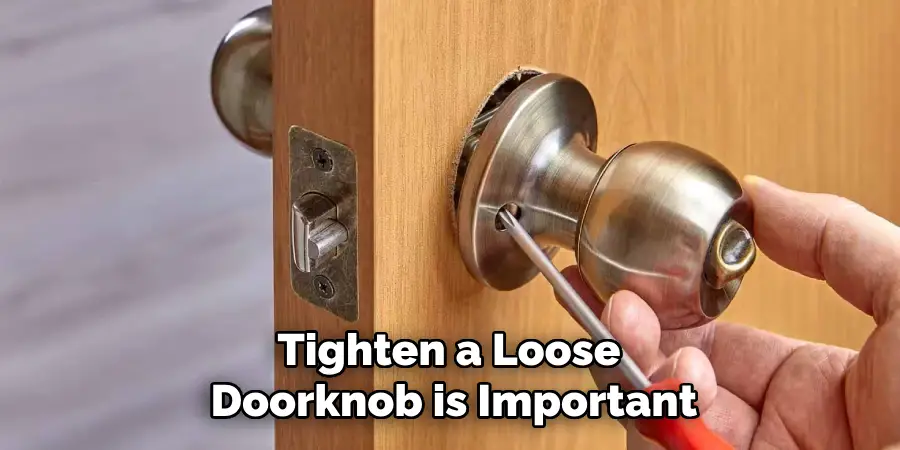
Conclusion
In conclusion, addressing a loose doorknob is essential for maintaining the security and functionality of your home. By following the step-by-step guide and utilizing the tips provided in this article, individuals can effectively tighten loose doorknobs and prevent potential security risks. Whether it’s identifying the root cause, selecting the right tools and materials, or implementing the appropriate tightening method for different types of doorknobs, taking proactive steps to address this issue is crucial.
Additionally, incorporating preventive measures such as regular maintenance and educating household members on proper use can help prevent future loosening. Thanks for reading, and we hope this has given you some inspiration on how to tighten a loose doorknob!

